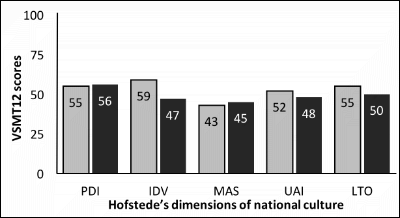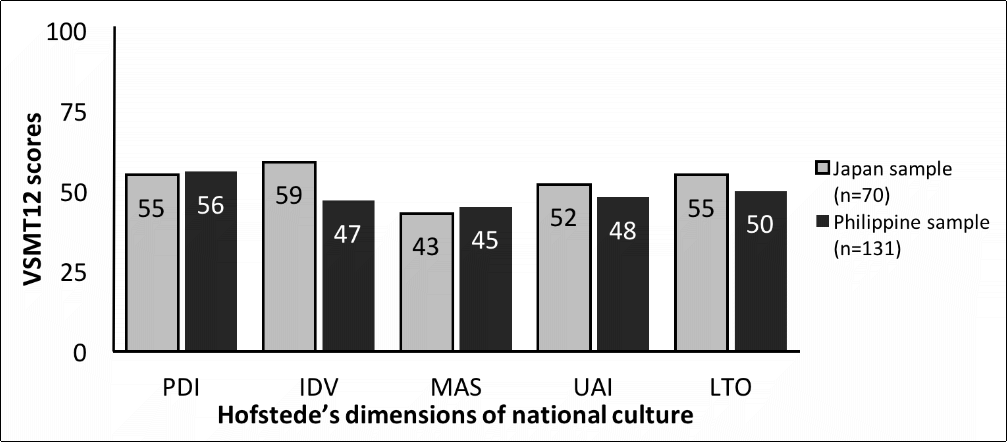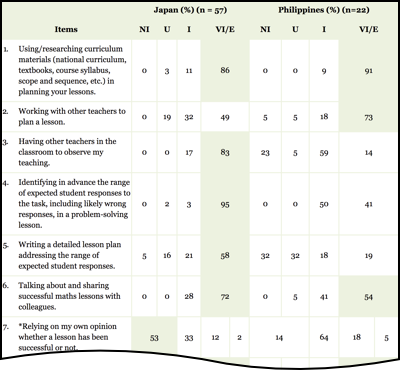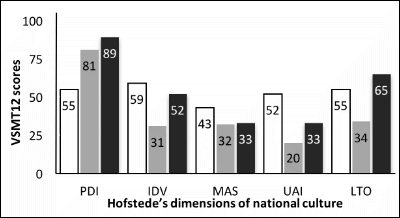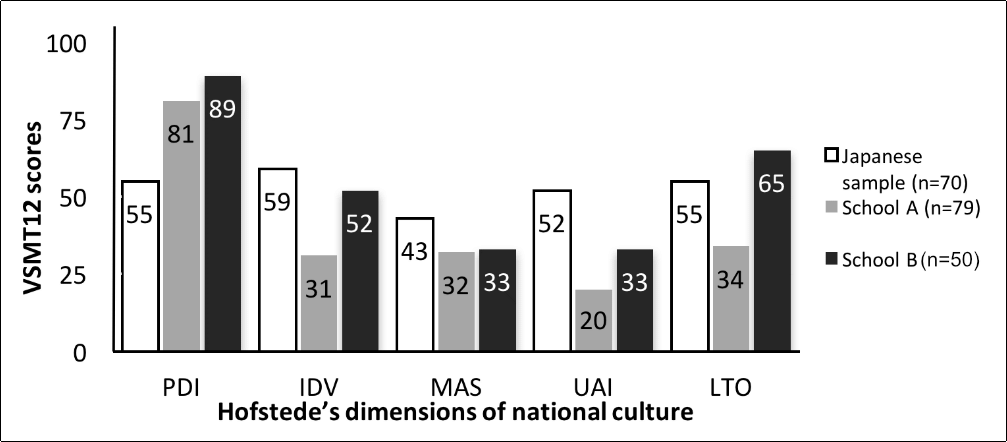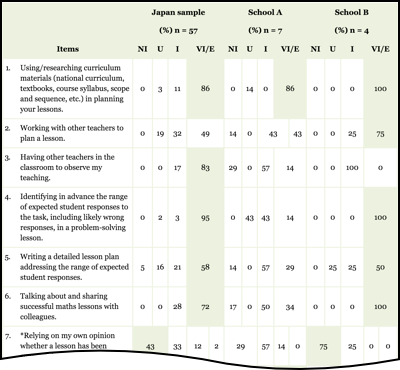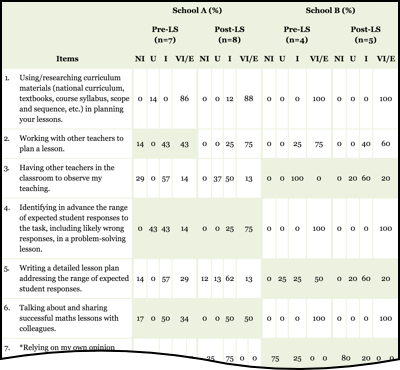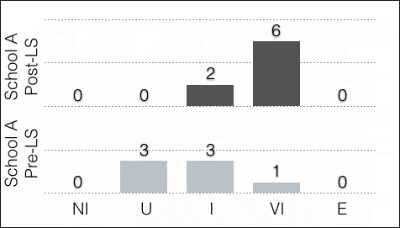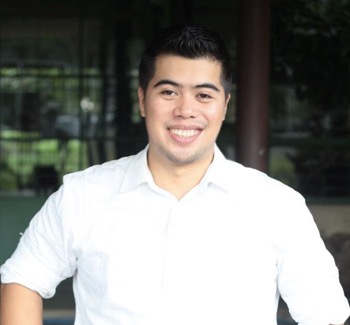
Designing Japanese Lesson Study as a teacher professional development program in a Philippine setting
Cultural considerations, challenges and opportunities
Marlon Ebaeguin
University of the Philippines: Manila
Abstract
i
Over the past two decades, there have been many efforts to translate Japanese Lesson Study to other countries. Most
of these efforts employed a simple “copy-paste” model that does not take into account culturally-rooted conventions
and practices, or differences in pedagogical beliefs and values. This study proposed a culturally embedded approach
to implementing Lesson Study that critically considers disparities between Japan and the Philippines as seen through
Hofstede’s dimensions of national culture. Results from two surveys of teachers identified areas of tensions and
incongruences between Japanese and Filipino teachers, and informed the design of a Lesson Study implementation at
two Philippine public high schools. At the end of three cycles of Lesson Study, many beliefs and skills of the 13
participating teachers had shifted positively in favour of Lesson Study. This study showed that a culturally
embedded approach enhances chances of a successful Lesson Study implementation, and could inform Lesson Study in
other contexts.
Introduction
ii
Philippines had poor performance in the last two Trends in International Mathematics and Science Studies (TIMSS) that it
participated in. This is a clear indication that there is a need for change in teaching if it wants its students to be
at par with their counterparts from other countries (Mullis, 2000;
Martin, Mullis, Chrostowski, & International Association
for the Evaluation of Educational Achievement, 2004). Existing strategies for professional development of teachers mainly
comprise of generic mass training of teachers (MTT), and the echoing of teachers who take turns in attending conferences
and workshops. These do not guarantee translation of new teaching practices into classrooms, and thus are ineffective
(Villegas-Reimers, 2003). With the Philippines’ transition to a K-12 curriculum, teachers need a professional development
program that can continuously provide them with more relevant and contextualised support, that is, a school-based professional
development program (Villegas-Reimers, 2003; Gallos & Herrington, 1997).
Japan’s consistently good results in international education tests have been attributed to Japanese Lesson Study (LS),
a school-based collaborative professional development activity for teachers (Stigler & Hiebert, 1999;
Ebaeguin & Stephens, 2014). Many international educators, who have been impressed by the capacity of Lesson Study to foster student
learning and sustained professional growth for teachers, have implemented it in their own contexts (Chokshi, 2002;
Inprasitha, 2011; Lewis, 2002; Lewis & Tsuchida, 1999;
Stigler & Hiebert, 1999; Pierce & Stacey, 2011). However, the
spread of LS to different countries over the past few decades has tended to rely on a simple transference model or a
‘copy-paste’ method with no attempt to address its cultural compatibility. With teaching and learning being
profoundly cultural activities and with Japanese LS originating from a practice that is more than a century old (Shimizu & Chino, 2015, p. 123),
it would be naive not to assume that culture would contribute to the extent to which
LS can be faithfully translated into and accepted by the teachers of the importing country. In what way then should LS
be adjusted if it is to work well in the Philippine context?
This study looked at the cultural underpinnings of Japanese Lesson Study and how these may hinder or facilitate implementation
of LS in another context, particularly in the Philippines. The study’s main research question is to find the cultural
adaptations needed to facilitate a smooth implementation of Lesson Study in Philippine schools. In particular, the study
will examine:
- What are the cultural underpinnings of Japanese Lesson Study?
- What are the conditions necessary to facilitate a smooth implementation of Lesson Study outside Japan?
- What are the potential challenges when implementing LS in Philippine schools?
- How can these challenges be addressed to facilitate a successful implementation of LS in Philippine schools?
- What models of implementation are likely to increase the success of Lesson Study in the Philippines?
Japanese LS originated in the 1800s when whole classroom instruction was being introduced to accompany the introduction of
universal primary education (Shimizu & Chino, 2015, p. 123). Open classrooms were conducted to encourage the proposal
of new teaching methods and teaching curricula. Inevitably, culture would have contributed in this long evolution of
these open classrooms into what is currently known as Japanese LS. Japanese LS has cultural underpinnings that need to
be understood and considered if it is to be implemented in a non-Japanese context like the Philippines. Looking at existing
literature on LS, this role of culture is overlooked by the many ‘copy-paste’ implementations, which explains
the misconceptions on and the challenges LS faces in different national contexts (Fujii, 2014).
To identify and analyse cultural orientations that support key practices in Japanese LS and to find a more critical approach
to its implementation outside Japan, Hofstede’s (2001) ‘dimensions of national culture’ were utilised.
Hofstede’s work focussed on comparing work-related values, behaviours, institutions, and organisations across nations
and his landmark studies, which commenced in the 1980s, were based on extensive samples of IBM employees who provided
him with nearly perfectly matched samples across countries (Hofstede, 2001; Hofstede, Hofstede, & Minkov, 2010).
His work is often used in business, marketing and in human resource training
(de Mooij, 2010; Henseller, Horváth, Sarstedt & Zimmermann 2010).
His dimensions of national culture, namely power distance (PDI), individualism versus collectivism
(IDV), masculinity versus femininity (MAS), uncertainty avoidance (UAI), and long-term orientation (LTO), were used to
focus on particular features of LS in Japan. It is also crucial to identify LS practices that are aligned with what the
teachers value in their profession. Thus, what the teachers value when planning a good mathematics lesson (values orientation),
as implied by LS, were also looked at. This study argues that a good understanding of a school’s cultural orientations
and the teachers’ values orientation is an important consideration to successfully implement LS.
Methodology
iii
This study consisted of an initial orientations survey study and a subsequent school research study. The orientations survey
study set out to answer research question (a) above (cultural underpinnings of Japanese LS), question (b) (conditions
necessary to facilitate smooth implementation of LS outside Japan, and question (c) (potential challenges when implementing
LS in Philippine schools). The school research, which is the main study, was directed to answer question (d) (addressing
identified challenges to facilitate a successful implementation) and question (e) (model/s of implementation that are
likely to increase the success of LS practice in Philippine schools).
Instruments
1
Two instruments were utilised for the study. First is the Values Survey Module for Teachers 2012 (VSMT12) which is adapted
from the Values Survey Module 2008 (Hofstede, 2010). This instrument was used to determine the school’s cultural
orientations based on the dimensions of national culture. The other instrument is the Mathematics Teachers’ Perceptions
of a Good Mathematics Lesson (MTPGML) which was developed by the researcher to determine teachers’ values orientations
and design perspectives. This second instrument was based on a synthesis of existing literature on Japanese LS, in which
key aspects of mathematics teaching as implied by Japanese LS are embedded (Fernandez & Yoshida, 2004; Lewis, 2002;
Lewis, Perry & Hurd, 2004). The 9 items can be seen in Table 1 below.
Orientations Survey Study
2
Both instruments were administered to a convenience sample of 70 junior high school teachers in Japan, 16 of whom were mathematics
teachers, and 131 high school teachers in the Philippines, 22 of whom were mathematics teachers. Because the 16 mathematics
teachers from Japan mostly came from Tokyo, another round of MTPGML, in the form of an online questionnaire, was administered
by the researcher drawing upon a wider sample of schools, resulting in a further 41 responses coming from different parts
of Japan. This gave a total of 57 mathematics teachers in the Japan sample. The non-mathematics and mathematics teachers
from each sample included both novice and experienced teachers. The results of this orientations survey study provided
an initial comparison between the Japanese and Philippine samples and groundwork for the subsequent school research study.
School-based research in the Philippines
3
The subsequent study, comprised of two phases, was conducted in two public secondary schools in the Philippines. School A
is a rural school, and School B is an urban school attached to a university. The first phase of this study involved administering
VSMT12 to
all teachers in both schools and MTPGML only to the mathematics teachers. Results from the first phase informed
the proceedings of the second study which only involved the mathematics teachers. An intensive training on LS was given
to all mathematics teachers in each school, and then, on a ‘voluntary basis’, eight teachers from School
A (four year 7 and four year 8) and five teachers (all year 7) from School B, proceeded to implement two to three cycles
of LS in their respective schools over a period of seven months (two to three months per cycle). Initially the researcher
was actively engaged as facilitator, followed by a gradual release of responsibility to the teacher participants. This
means in the last cycle, the teacher participants were completely in charge of the planning and implementation of the
research lesson, while the researcher took on a passive role as a member-observer in the group.
With most of its characteristics parallel to the process of LS, design-based research
(Anderson & Shattuck, 2012; Barab & Squire, 2004;
Cobb, Confrey, diSessa, Lehrer & Schauble, 2003) easily lent itself as the research methodology for the main study.
How the thirteen participating teachers progressed through each cycle was analysed using teacher reflections and interviews,
which then informed the changes in the strategies and focus of the succeeding cycle.
At the end of three LS cycles in School A and two cycles in School B, the participating teachers where asked to re-take the
MTPGML to see if there was any shift in their values orientations. Exit interviews were conducted where teachers were asked
to reflect on their LS experience, focussing on the shifts in their values orientations, and to analyse a mathematical task
and a student’s solution to that task. All teachers were asked to submit several lesson plans: one provided by the
Department of Education, one they had designed prior to the LS intervention, one during the LS intervention, and one after
the LS intervention. Using mixed data analysis and cross-iteration comparison, all teacher artefacts were analysed and
compared with their MTPGML results to see both whether they validate each other and to identify areas of teacher change.
Results
iv
Orientations Survey Study
Figure 1 below shows the VSMT12 results for the Japanese and Philippine samples. The data shows that the Japanese
sample tended to be moderately hierarchical and individualistic, which means they acknowledge positions of
power but do not let these features intimidate them when in a collaborative environment - everyone's opinion
or ideas should be heard. Furthermore, this sample of Japanese teachers endorsed moderately feminine qualities,
which means instead of competitiveness in a group, consensus is usually preferred and harmony within the
group is generally sought. Also, the Japanese sample was moderately
uncertainty avoiding and moderately
long-term oriented which means attention to detail is valued and a certain level of commitment could
be expected from them (de Mooij, 2010; Hofstede, 2001; Hofstede, Hofstede & Minkov, 2010). The VSMT12
results of the Philippine sample are generally similar to those of the Japan sample. This evidence suggests
an absence of any major problem arising from the values orientations for introducing LS to these teachers.
Table 1 summarises the results of MTPGML administered only to the mathematics teachers in Japan and Philippine samples. From
Table 1, combining the percentages for Very Important (VI) and Essential (E) shows that the Japan sample has very strong
endorsements for eight out of the nine key elements. The Japan sample’s relatively low response to Item 2 (31%
VI and 18% E) compared with teachers in the Philippine sample (50% VI and 23% E) on
"Working with other teachers to plan a lesson" may appear strange. However, this may be explained by the fact that
Japanese teachers distinguish clearly between those occasional lessons that are planned with other teachers as part of
LS and those lessons that are part of day-to-day teaching which they are more likely to plan alone. Item 1 (Researching
curriculum materials), Item 4 (Identifying in advance the range of expected student responses), and Item 9 (Getting involved
in school research) were considered E by 54%, 63%, and 54%, respectively, of the sampled Japanese teachers. In contrast,
Item 4 and Item 9 were rated E only by 9% and 14%, respectively, of the sampled Filipino teachers. Since LS is a collaborative
activity, other people's opinion is as important as one's own when determining the success of a lesson, so it is important
to get lower values for Item 7 (Relying on one's own opinion in determining success or failure of a lesson). On Item
3, 53% of the Japanese sample and 19% of the Philippine sample were between Undecided and Not Important, which is consistent
with both samples’ endorsement of having other teachers in the classroom to observe teaching. This is supported
by the Japan sample’s moderate IDV orientation. Furthermore, the moderate
uncertainty avoiding (UAI) and
long-term (LTO) orientations support many of the items below, particularly the strong inclinations for attention
to detail in lesson planning and engagement in research.
The Philippine sample’s weak endorsements for Items 3,
4, 5 and 7 seem to be inconsistent with its moderate
individualism (IDV),
uncertainty avoidance (UAI), and
long-term (LTO) orientations. With apparent cultural strengths in each of the factors that would seem to suit lesson
study, these data suggest why Japanese teachers seem to be able to engage meaningfully in LS and what could be potential
sources of tension for the Philippine teachers, answering question (c) of the study. The clearest divergences in terms
of lesson design are shown in responses to Items 4 and 5, especially in Item 4 where 58% Japanese teachers considered
Very Important or Essential
Writing a detailed lesson plan addressing a range of expected student responses compared to 19% of the Philippine
sample.
School-based research study in the Philippines
2
Figure 2 below shows the results obtained during the first phase of the study in Schools A and B. These results reveal disparities
in each Hofstede dimension between mathematics teachers in the Japan sample and the two Philippines schools. These suggest
potential sources of tensions or design challenges when implementing LS in Philippine schools. Power distance index (PDI),
which relates to hierarchy, and uncertainty avoidance index (UAI), which relates to openness to change and attention
to detail, are major considerations and needed to be addressed. Figure 2 also reveals that even though School A and School
B are from the same country, they appear to have different cultural orientations, as can be seen in
individualism versus collectivism (IDV) and
long-term versus short-term orientation (LTO). This means a different set of strategies would need to be employed
between the two schools.
With the VSMT12 results at hand, the researcher needed to design strategies that could address the issues on high PDI, low
UAI and low LTO (for school A). For example, the researcher requested the immediate supervisors like the department head
and the district supervisor for mathematics to be involved to keep the teachers in the program and to encourage them
to take activities seriously. To ensure that the presence of superiors and a ‘seniority complex’ did not
skew discussions, the researcher as the facilitator made sure that everyone’s opinions were heard and that tasks
were fairly delegated to everyone, allowing novice teachers to take on important roles. There was also a gradual release
of responsibility from the researcher to the teachers. To address the low UAI, the researcher allocated more workshops
on anticipating the widest range of student responses to problem-solving tasks and provided support for such responses
to help teachers see the benefits of writing a detailed lesson plan. Because School A had low IDV, the researcher encouraged
the teachers to write their reflections on what they learned independently.
Table 2 shows the pre-LS results of MTPGML for the Japanese sample, School A and School B. The strong alignment between
the key aspects of LS and what the Japanese teacher sample valued in lesson planning helps explain further why LS
works smoothly in Japan. Comparing the values orientations of both participating schools to the Japanese sample allowed
the researcher to identify the focus of the sessions. For instance, teachers from both schools (A and B) need to
be convinced about the value of having other teachers observe their teaching and of writing a detailed lesson plan
addressing the range of expected student responses. Also, it should be noted that teachers from both schools were
quite different in terms of their values orientations. This phase of the study was set out to address question (d)
of the study. Teachers in School A, the rural school, needed more explanation of aspects which were the focus of
their training sessions, whereas teachers in School B seemed to be willing to go along with what was proposed by
the researcher.
These results from VSMT12 and MTPGML guided the progression of the teachers through each LS cycle. Over a period of seven
months, the researcher worked with teachers in School A, meeting them twice a month, whereas meeting the teachers from
School B even once a month proved to be a challenge. One reason for this difficulty was the availability of the teachers.
School B was in the middle of moving to a new campus and the teacher in charge of Year 7 mathematics was on leave. Over
the seven-month period, two LS cycles were conducted at School B, while School A conducted three.
At the end of the intervention, the participating teachers were again asked to take MTPGML. The shifts in their values
orientations, if any, are indications of teacher growth. This analysis of the shifts was done for each Philippine
school and for both Philippine schools combined. The very small sample size, which is a clear limitation of the
study, limited the analysis of the results.
At this point, the unit of analysis now shifts to the individual items in MTPGML and how the shifts in each item
correspond to the teachers’ responses in their exit interviews. Table 3 summarises the endorsements of
the teachers from School A and School B, pre- and post-LS intervention.
Teachers from School B seem to have changed little from their endorsements which were mostly high and desirable to begin with. However, in the exit interview when they were asked to analyse a problem-solving task and a student’s solution to the task, many teachers in School B struggled to describe a possible flow of a lesson using the task and to hypothesise student’s reasoning behind the sample solution. This finding does not align with their strong endorsement for item 4 “Identifying in advance the range of expected student responses to the task, including likely wrong responses, in a problem-solving lesson”.
Teachers from School A experienced more shifts in their values orientations. A major shift in item 4 can be seen in
Figure 3, which shows the endorsement for item 4 of the Japanese sample,
and School A teachers, pre- and post-LS. Exit interview from teachers supported this finding.
A1, an experienced teacher of 5-10 years of teaching:
“It helped me to construct a good lesson plan wherein we need
to consider the students’ anticipated responses. It’s only now that I realised the need to consider these
because you can use them to develop the flow of your lesson by connecting the students’ ideas from one another.”
A5, another experienced teacher:
“Readiness in dealing with my students every day. Usually, we only expect the correct
answer to be given. When a wrong answer is given, we assume that all the wrong responses are the same. But through LS,
we consider all possible student responses so we’re able to prepare responses in case a wrong response comes up.”
In contrast, B1, a teacher with more than ten years of teaching experience, was not so confident about this aspect:
“The
range of expected… my point of view is it’s important because you can anticipate the problem [in the actual
class] if you've prepared the expected student responses [beforehand]. I’m thinking…you can’t really
anticipate [everything]… especially by yourself…”
Conclusion
v
VSMT12 results for the Japanese sample point to important cultural underpinning of the values embedded in LS. The moderate
PDI (Power Distance Index) and IDV (Individualism/Collectivism) measures explain the high regard for collegiality, while
moderate UAI (Uncertainty Avoidance Index) and LTO (Long Term Orientation) help explain the importance given to detailed
lesson planning and to seeing LS as continuous and on-going program of teacher professional growth. These orientations
cannot be assumed to be present in other national contexts as seen from the VSMT12 results of the two Philippine schools.
In the MTPGML, the consistent strong endorsements of the Japanese sample for the key aspects of LS may explain why Japanese
teachers readily participate in and are able to maximise their learning from LS. The clear differences between the Japanese
sample and the teachers from schools A and B show that we cannot assume the same values orientations from other teachers.
It is likely that many other Philippine schools will yield similar results from both instruments; that is, very high
PDI, very low UAI, very low LTO. Our conclusion is that a ‘copy-paste’ method is likely to not work at all.
Orientations that underpin the success of LS in Japan are themselves not easily transported to other countries, if indeed
it is possible.
Failing to take account of different cultural and/or values orientations means that tensions, misinterpretations, misconceptions,
and even resistance from teachers may arise. Results from the two instruments alerted the researcher to anticipate potential
challenges in implementing LS in the two schools. The researcher was far better placed to design a model that incorporated
strategies which addressed these anticipated challenges and harnessed identified affordances — that is what a culturally
embedded approach requires.
The researcher cautions other implementers of LS, especially in the Philippines, that this study does not provide a recipe
for implementing LS in any Philippine school. For both instruments, the two schools shared some cultural and values orientations
but they also exhibited differences from each other despite coming from the same country. This means each intervention
must be tailored to the needs of the schools. Designing and implementing a LS program should be locally informed.
Furthermore, we recommend that implementers need to be careful in their interpretations of results from the two instruments.
It is important to be alert to social acceptability bias, when respondents give responses they think a researcher wants
to hear, or what they think they should say. MTPGML results alone should never be taken as indicators that change has
actually occurred. They need to be supported by evidence from what has happened in the classroom and how teachers respond
to that evidence. One of the fundamental strengths of LS is to look for evidence of teacher change not in what teachers
say, but in what they know and can do. One of the fundamental design principles of LS in its planning stage is to focus
on students’ thinking processes; and consequently, to direct attention in the lesson implementation and observation
stage towards collecting evidence of how students’ thinking has been demonstrated, improved and challenged. These
data become the basis to build into the next cycle. The above cautions and recommendations provide answers to question
(e) concerning what models of implementation are likely to increase the success of LS in the Philippines.
Lesson Study is recognised in many countries as having the potential to foster teacher growth. However, this is not achieved
merely by learning the processes and the skills needed to participate in it. The processes and skills that make LS successful
in Japan are not simply a set of transportable behaviours that can be shifted seamlessly to other countries. They need
to be seen as embodying and reflecting values that are specific to Japan. This study does not claim that culture alone
will facilitate LS smoothly as there are other factors that also come to play such as support from the administration,
teacher selection, etc. However, knowing the disparities in the orientations with the importing culture allow us to be
more strategic in LS design and development of teacher professional change. The study also showed that even within the
same country, schools’ cultural and values orientations may vary and, thus, different strategies for implementation
are needed. This study showed that culturally grounded aspects of LS contribute to how they are embraced by the teachers
in the importing culture. A culturally embedded approach to implementation builds on the teachers’ cultural and
values orientations which can facilitate a locally appropriate implementation of LS. The shift in endorsement of some
key aspects of LS analysed at the item level, and reflections from teachers provide solid evidence of teacher professional
growth. This shows that LS, if adapted and implemented appropriately to the local environment, can provide teachers with
opportunities for sustained professional growth and improved student learning.
References
vi
Anderson, T., & Shattuck, J. (2012). Design-based research: A decade of progress in education research? Educational Researcher, 41(1), 16-25. doi:10.3102/0013189X11428813
Barab, S., & Squire, K. (2004). Design-based research: Putting a stake in the ground. Journal of The Learning Sciences, 13(1), 1-14.
Chokshi, S. (2002). Timeline of U.S. lesson study. Retrieved from http://www.tc.columbia.edu/lessonstudy/timeline.html (no longer available)
Cobb, P., Confrey, J., diSessa, A., Lehrer, R., & Schauble, L. (2003). Design Experiments in Educational Research. Educational Researcher, 32(1), 9-13.
de Mooij, M. (2010). Global marketing and advertising: Understanding cultural paradoxes. Los Angeles: SAGE.
Ebaeguin, M. & Stephens, M. (2014). Cultural challenges in adapting lesson study to a Philippines setting. Mathematics Teacher Education and Development, 16(1), 43–64.
Villegas-Reimers, E. (2003). Teacher Professional Development: An International Review of the Literature: International Institute for Educational Planning.
Fernandez, C., & Yoshida, M. (2004). Improving mathematics teaching and learning: The Japanese lesson study approach (Studies in Mathematical Thinking and Learning Series). Mahwah, NJ: Lawrence Erlbaum Associates.
Fujii, T. (2014). Implementing Japanese lesson study in foreign countries: Misconceptions revealed. Mathematics Teacher Education and Development, 16(1), 65–83.
Gallos, F, & Herrington, T. (1997). The effectiveness of a professional development program based on action research. In A. Begg (Ed.), People in mathematics education. Proceedings of the Twentieth Annual Conference of the Mathematics Education Research Group of Australasia (MERGA-20) (pp. 184-191). Rotorua, New Zealand: MERGA.
Henseller, J., Horváth, C., Sarstedt, M., & Zimmermann, L. (2010). A cross-cultural comparison of brand extension success factors: A meta-study. Journal of Brand Management, 18(1), 5–20.
Hofstede, G. (2001). Culture's consequences: comparing values, behaviours, institutions, and organizations across nations. Thousand Oaks, CA: Sage.
Hofstede, G., Hofstede G. J., & Minkov, M. (2010). Cultures and organizations: Software of the mind: Intercultural cooperation and its importance for survival. New York: McGraw-Hill.
Inprasitha, M. (2011). One feature of adaptive lesson study in Thailand: Designing a learning unit. Journal of science and mathematics education in Southeast Asia, 34(1), 47-66.
Lewis, C., Perry, R., & Hurd, J. (2004). A deeper look at lesson study. Educational Leadership, 61(5), 18–22.
Lewis, C., & Tsuchida, I. (1999). A lesson is like a swiftly flowing river: How research lessons improve Japanese education. American Educator, 2(1), 48-56.
Martin, M. O., Mullis, I.V.S, Chrostowski, S. J. (2004). TIMSS 2003 Technical Report: Findings from IEA's Trends in International Mathematics and Science Study at the Fourth and Eighth Grades. TIMSS & PIRLS International Study Center.
Mullis, I.V.S. et al. (2000). TIMSS 1999: international mathematics report: findings from IEA's repeat of the Third International Mathematics and Science Study at the eighth grade. Chestnut Hill, MA: International Study Center, Boston College. https://timss.bc.edu/timss1999i/math_achievement_report.htm
Pierce, R., & Stacey, K. (2011). Lesson study for professional development and research. Journal of Science and Mathematics Education in Southeast Asia. 34(1), 26 – 46.
Shimizu, S., & Chino, K. (2015). History of lesson study to develop good practices in Japan. In M. Inprasitha, M. Isoda, P. Wang-Iverson, & B. H. Yeap (Eds.), Lesson study: Challenges in mathematics education (pp. 123-140). New Jersey: World Scientific.
Stigler, J. W., & Hiebert, J. (1999). The Teaching Gap. New York, NY: Free Press
Note & Acknowledgement
vii
This article builds on the paper “Cultural Challenges in Adapting Lesson Study to a Philippines Setting” by M. Ebaeguin & M.
Stephens (Mathematics Teacher Education and Development, 2014, Vol. 16.1, pp 43-64). The data in Figure 1 was published
in the earlier paper. The data from the Philippine sample in Table 1 was also previously published, but the Japanese
data comes from an expanded sample (41 participants were added and a minor correction was made). The abstract to the
present article was revised on 9 Aug 2019.
About the Author
viii
Marlon Ebaeguin is an Assistant Professor of Research and Evaluation at the College of Education, University of the Philippines,
Diliman. He is currently completing his PhD in education at The University of Melbourne. He completed his master's degree
in mathematics at the University of the Philippines, and worked as a secondary and college mathematics instructor before
going on a teacher training scholarship at Tokyo Gakugei University. His areas of research interest include mathematics
education, teacher education, problem solving in mathematics, and cross-cultural comparisons.

